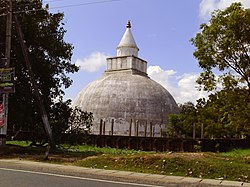| This article needs additional citations for verification. Please help improve this article by adding citations to reliable sources. Unsourced material may be challenged and removed. Find sources: "Tissamaharama" – news · newspapers · books · scholar · JSTOR (August 2017) (Learn how and when to remove this message) |
| Tissamaharama | |
|---|---|
| Town | |
 Yatala Vehera Stupa Yatala Vehera Stupa | |
 | |
| Coordinates: 6°17′N 81°17′E / 6.283°N 81.283°E / 6.283; 81.283 | |
| Country | Sri Lanka |
| Province | Southern Province |
| District | Hambantota District |
| Area | |
| • Total | 840 sq mi (2,180 km) |
| Elevation | 62 ft (19 m) |
| Population | |
| • Total | 79,618 in 2,011 |
| Time zone | +5.30 |
Tissamaharama (Sinhala: තිස්සමහාරාමය [ˈtissəmaˌhaːˈraːməyə], Tamil: திஸ்ஸமஹாராம) is a town in Hambantota District, Southern Province, Sri Lanka.
History
It was the capital of the Kingdom of Ruhuna as early as the 3rd century B.C. Few buildings from that period survived. The presence of early Tamils in Tissamaharama was confirmed following archaeological excavations in 2010. The Tissamaharama Tamil Brahmi inscription, a fragment of black and red ware flat dish inscribed in Tamil in the Tamil Brahmi script was excavated at the earliest layer in the town.
The large, artificial Tissa Wewa lake, which was a part of an irrigation system, dates from that time. The five main nearby lakes are Tissa Wewa; Yoda Wewa; Weerawila Wewa; Pannegamuwa Wewa; and Debarawewa Wewa.
The town mainly serves as a starting point for visits to Yala National Park and Kataragama.
Archaeology
The archaeological excavations brought to light earliest urban phase in the 4th century BC. Fired bricks, Buddhist saddle querns, a potsherd with triangular sail (excavated from the layer of 1st century BC but on stylistic grounds were assigned to 3rd century BC), a hospital from 1st century AD-2nd century AD, (the earliest in south Asia), stone paved streets with drains and water channels dated before the Common Era, roof tiles, houses with plastered exterior etc. A Tissamaharama potsherd with alleged Tamil Brahmi inscription was unearthed, however the scripts revealed a unique language.
See also
References
- Mahathevan, Iravatham (24 June 2010). "An epigraphic perspective on the antiquity of Tamil". The Hindu. Archived from the original on 1 July 2010. Retrieved 31 October 2010.
- Ragupathy, P (28 June 2010). "Tissamaharama potsherd evidences ordinary early Tamils among population". Tamilnet. Tamilnet. Retrieved 31 October 2010.
- Weisshaar, Hans-Joachim (January 2001). Weisshaar, Hans-Joachim; Roth, Helmut; Wijeyapala, W. (eds.). Ancient Ruhuna. Sri Lankan – German Archaeological Project in the Southern Province. Vol. 1. Mainz: Philipp von Zabern.
- Weisshaar, Hans-Joachim (January 2015). "Ancient Tissamaharama: the formation of urban structures and growing commerce.". In Tripati, S. (ed.). Maritime Contacts of the Past: Deciphering Connections Amongst Communities. New Delhi: Delta Book World. pp. 208–228.
- Weisshaar, Hans-Joachim (January 2014). "Legged Saddle Querns of South Asia". Zeitschrift für Archäologie Aussereuropäischer Kulturen. 6: 119–144.
- Weisshaar, Hans-Joachim. "How to get water, and how to dispose? Water Management in an Early Urban Society of South Asia". In Nickel, C.; Weisshaar, H.-J.; Shadullah, A. M.; Shafi, S. A. (eds.). Man and Water. Seminar on Archaeology, Supply and Sanitation in Bangladesh and Beyond. Dhaka: Goethe-Institut. pp. 23–32.
- "Tissamaharama potsherd with alleged Tamil Brahmi inscription". 8 December 2023.
External links
This Southern Province, Sri Lanka location article is a stub. You can help Misplaced Pages by expanding it. |